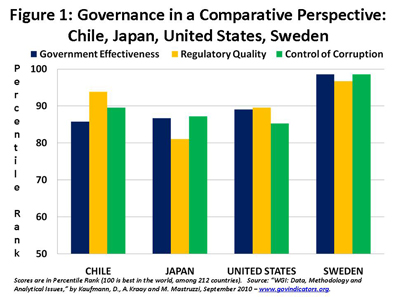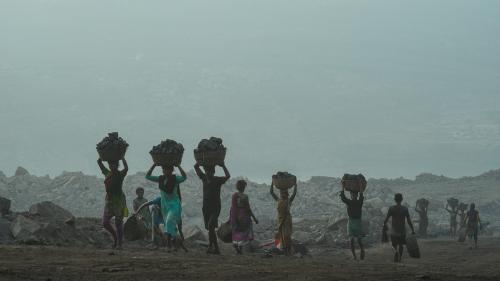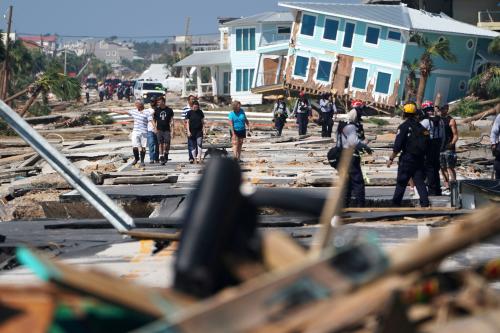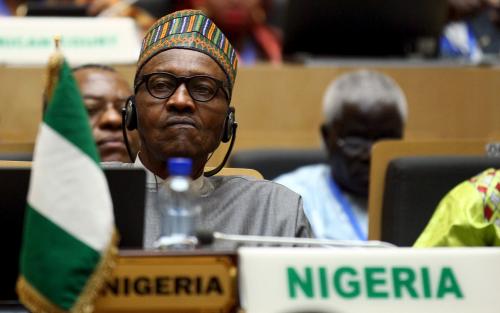In the wake of its triple disaster, Japan finds itself at the center of its most dramatic crisis since World War II. But governance shortcomings may be imperiling the response.
Last Friday, the country was hit by a devastating mega-earthquake, tsunami and nuclear disaster. It will take weeks to fully assess the human and physical toll of these calamities. Yet officials have acknowledged that the death toll will likely exceed 10,000 people. Hundreds of thousands remain homeless and without electricity, heat or clean water, and there is a high risk of radiation spreading over vast areas, including where the homeless have sought shelter.
In the coming months, the extent of Japan’s disaster-preparedness will be fully scrutinized, as will its handling of the response, relief and reconstruction efforts. While it is early to provide a full analysis, it is possible to identify salient challenges that may warrant closer attention. In particular, we explore Japan’s governance in an international context and its impact on the country’s crisis response.
Japan has had satisfactory governance in general, but is far from a model. As discussed last year in the context of the mega-earthquake that struck Chile, countries with good governance can better prepare for and mitigate the devastating effects of natural disasters. When major earthquakes strike near populated areas, casualties are unavoidable. However, many deaths can be averted in well-governed settings, as was the case with Chile.
In recent years, Japan has rated well on governance relative to other countries. Based on the Worldwide Governance Indicators (WGI), Figure 1 suggests that Japan rates among the top 30 countries in the world on “Government Effectiveness” and “Control of Corruption” and in the top 40 on “Regulatory Quality”. Unsurprisingly, Japan’s governance performance is far superior to that of struggling developing countries like Haiti, where 230,000 people died last year from a devastating earthquake. However, while Japan is the third largest economy worldwide, it rates in the bottom half of industrialized OECD countries in governance, scoring below an emerging economy like Chile, slightly below the U.S., and far below model Scandinavian countries.

An initial assessment of Japan’s response to each of the three disasters suggests a combination of the country’s governance resilience as well as its salient shortcomings.
The Earthquake
In recent years, Japan has implemented regulations and policies that made the country well-prepared for earthquakes. Although the death toll from Friday’s disaster is high, the vast majority of deaths are due to the tsunami. This current situation is in contrast to the Kobe earthquake of 1995. The 7.9-magnitude quake in 1995 resulted in 6,000 deaths, 5,000 of which occurred in the first few seconds as a result of collapsing structures. The government has since continued to educate and drill its public on what to do in case of an earthquake or tsunami, and has strengthened its infrastructure.
Japan has implemented and enforced stricter building codes than most other countries, including the U.S. Therefore, Japanese buildings tend to be stiffer and stouter than those in earthquake-prone California. Following the Kobe disaster, Japan spent hundreds of millions developing an earthquake early-warning system. In Tokyo, over a minute before the quake hit, alerts were sent to millions of cell phones, trains were halted and stations interrupted broadcasts to provide warnings.
In the immediate earthquake aftermath, phone signals went dead to allow more bandwidth for emergency services. However, the Internet continued to function so people could get in touch and share news and videos. The remarkable calm and resilience of the Japanese people has prevailed in cities that were only impacted by the earthquake — such as Tokyo, where citizens slowly made their way to work on Monday despite the shock and rolling blackouts sanctioned by the government to conserve energy. In an unprecedented move, Japan’s Emperor Akihito has calmly addressed the nation in lay language in his first appearance on television ever. No looting has taken place and the Bank of Japan responded quickly by pumping nearly $700 billion into the economy by Wednesday to stabilize the stock market. So far, it seems like Japan has responded well to the direct impact of the earthquake.
Tsunami Warning and Fallout
The earthquake caused a subsequent tsunami, which hit the coast of Japan and swept away and killed thousands.
Because of its long history of tsunamis, Japan has invested in early-warning systems. The system seems to have worked properly since the government issued a local tsunami warning throughout the coast within three minutes of the quake. Japan also installed seawalls along nearly 40 percent of its coastline, some standing 45 feet high. However, they were no match for this tsunami, which spilled over seawalls and sped into communities far inland.
Damaged communications and infrastructure across the country slowed the government’s initial response to the tsunami. However, the government should be credited for quickly mobilizing 100,000 troops for search and rescue missions and for using sea and air routes to ferry supplies to the most-afflicted and hardest to reach areas. Tragically, there seems to be relatively few injured or trapped citizens awaiting rescue. In the days and weeks to come, the government will need to provide shelter, heat, water and food to its large displaced population. The Japanese government has so far performed average in responding to the tsunami.
Nuclear Disaster
The response to the nuclear power plant crisis has been subpar, reflecting serious shortcomings in leadership and governance. Since Friday, the Fukushima Daiichi nuclear plant has experienced explosions in reactors 1 and 3, a blast in the suppression pool of reactor 2, and storage pond fires in reactor 4 that appear to be ongoing. The containment vessels of reactors 2 and 3 have been cracked and are releasing radioactive steam. Uncommon overheating in the storage pools of inactive reactors 5 and 6 are also taking place, raising the risk of major leakage further. All six reactors seem to be compromised to varying degrees. As of today, the situation appears to be deteriorating further and far from being under control.
Once again, radiation levels spiked earlier today, forcing the few workers remaining to briefly flee indoors and leave cooling efforts temporarily unattended. This nuclear crisis, involving so many different reactors and spent fuel pools simultaneously, is unprecedented. Risk models describing this scenario do not seem to exist, and the demands of containing the radiation from the possible meltdown of three reactors and from the burning spent fuel of any of the six reactors are enormous. And so far it has not helped that there has been a leadership void in terms of anybody in government taking charge of this crisis, combined with a seeming inability to improvise, to deploy major resources, and to act quickly and resolutely in the face of an unprecedented and fast evolving crisis.
The nuclear crisis is now only a close second to Chernobyl, and it is not subsiding. The 40-year old nuclear plant was designed to withstand a major earthquake, which it initially did. However, the tsunami breached the plant’s seawalls and disabled all back-up generators, leaving only battery-power to run cooling systems, which ran out of power in a few short hours. With the cooling systems having failed since Friday’s tsunami, only a few dozen brave workers and soldiers have been left at the plant to try and stave off a nuclear meltdown by flooding reactors with seawater.
The Japanese government has already evacuated over 200,000 people residing within 20 kilometers of the plant. The unfolding situation appears to be critical and has been exacerbated by poor governance of all the key actors responsible for Japan’s nuclear industry: the industry/operator (Tokyo Electric Power Company, Tepco), the regulator (Nuclear and Industrial Safety Agency, NISA) and the government. One should note that these failures are not only made in Japan. For instance, the International Atomic Energy Agency (IAEA) has not been active in stemming this crisis, which now seems to rest in the hands of a few courageous workers. In fact, the head of the IAEA, who is also Japanese, has not arrived to Japan yet.
TEPCO’s Failures: The utility operator, the Tokyo Electric Power Company (TEPCO) may not have exhibited the same egregious governance failures as Soviet bureaucrats did in 1986, but its performance record has been subpar for a very long time.
It is a matter of record that in 2002 TEPCO admitted to falsifying the results of safety tests on reactor one’s containment vessel. In previous decades, the company had doctored reactor shroud safety records. In 2003, TEPCO prohibited inspectors from visiting reactors and later acknowledged that it systematically covered-up inspection data that showed cracks in reactors. Following a relatively small earthquake in 2007, a fire ensued at another nuclear plant, and TEPCO masked the fact that hundreds of gallons of radioactive water leaked out.
Making matters worse, TEPCO’s response to the ongoing nuclear crisis has been seriously flawed. The operator has infuriated Japan’s prime minister, who learned of the first plant explosion at reactor 1 on Saturday from watching TV. More generally, TEPCO has angered the public and media by providing only partial briefings, refusing to answer questions during press conferences, providing vague and delayed information and preferring to apologize for “causing inconvenience” instead of keeping the people truly apprised of developments.
TEPCO’s performance has been troubling virtually across the board. The only exception is on the human front, where the dozens of workers who have remained behind, alongside some brave soldiers, may be making the ultimate sacrifice in order to protect their fellow citizens.
Regulatory Failure: The Fukushima Daiichi nuclear plant crisis is exposing the extent to which Japan’s powerful nuclear industry has been subject to lax oversight, or worse. For starters, the effectiveness of the regulator comes into question in light of TEPCO’s history of deceit. In assessing governance in the industry, it would be unfair to single out only one company, when the entire industry was not subject to proper oversight.
In 2007, Japan’s government and power industry were warned that plants like Fukushima Daiichi were not built to withstand major earthquakes. Between 2005 and 2007, atomic power plants in Onagawa, Shika, Kashiwazaki-Kariwa and Kushiwazaki were affected by tremors beyond those which they were built to withstand. Since the 1970s, safety inspectors at the U.S. Atomic Energy Commission (AEC) have warned that General Electric reactors, the type employed in Fukushima Daiichi, were vulnerable to explosions and radiation release if a meltdown occurred. Yet to date, no actions had been taken by the Japanese government to modify nuclear plant standards.
Lax oversight of existing regulations is also to blame. In 2004, five workers were killed at a nuclear plant when superheated steam punctured a pipe. It was later discovered that the pipe had not been inspected in 28 years. In 2007, the Nuclear and Industrial Safety Agency (NISA) forced companies to reveal unreported safety breaches. Ultimately, seven out of 12 public utilities admitted to falsifying records.
Regulatory capture may have also contributed to the current situation. Many in the industry come through the revolving door, acting at different times in the licensing, rulemaking and inspections process. The rulemaking process also appears to be riddled with conflict of interest. In fact, when Japan rewrote its safety rules, 11 of 19 members of the panel belonged to Japan’s main lobby group for power companies, Japan Electric Association. Reportedly, it may in nuclear power where the industry and the regulator have the coziest of relations in Japan.
Further, NISA is also not an independent agency. It is a department under Japan’s Ministry of Economy, Trade and Industry (METI), which is responsible for expanding nuclear power generation. In recent months, METI has teamed up with power companies, including TEPCO to win nuclear deals abroad. The dire consequences of low regulatory independence are well exemplified by the U.S.’s Minerals and Management Service, which prior to the BP Oil Spill in 2010 was responsible both for the promoting and overseeing the oil industry.
Japan’s regulatory weakness is also suggested in figure 1 above, where the country’s regulatory quality is far lower than the OECD average, and even some emerging economies such as Chile. Just as the U.S. had to reassess its regulation of the oil sector after the BP spill, Japan will also need to address the regulatory failure (and elements of capture) in the nuclear industry.
Government Failure and Lack of Transparency
The government shares blame with regulators for not heeding warnings, for not creating an independent regulatory agency and for facilitating or at least not hindering coziness between the regulator and regulated by encouraging the expansion of nuclear energy domestically and internationally.
So far, Japan’s government has exhibited lack of leadership and largely failed to manage the crisis effectively. Prime Minister Kan’s administration was not informed for an entire hour of the first explosion on Saturday or of the decision to evacuate 740 non-essential staff from Fukushima. The lack of public disclosure falls as much on the government as it does on TEPCO. Thus far, the administration has done little to beef up resources and personnel at the plant. Currently just over 100 workers are battling to avoid catastrophic failure in the six reactors.
The government’s response to the nuclear disaster has also not been fully transparent, even if some lower level officials have tried to be somewhat forthcoming. Disclosure on issues related to the nuclear disaster by both the government and TEPCO has been partial at best, and may have been misleading at worst. Most communications have been vague, confusing, not particularly timely, and have tended to present a rosier picture than the actual situation. It took a full five hours after the first reactor explosion for the government to report that no radioactive material had been leaked. In Fukushima, a plant employee and his family were ordered by a local official to stop discussing what they had seen.
Given the opaque nature of the government’s response, some key concerns remain. It is unclear how much total radiation has leaked into the atmosphere or how much lethal plutonium has escaped from reactor 3, which uses mixed oxide (MOX) fuel. No information has been provided on the chemical composition of the radiation being released. And until Tuesday’s explosion at reactor 4, the possible threat from storage ponds was not even discussed by the government or TEPCO, even though it appears that from the start that this was a major concern. It is likely that the evacuation zone imposed by the Japanese authorities is far too restricted given how much radiation has leaked (some outside experts suggest closer to 80 Kilometers at this juncture, not 20).
Even now, as contingency plans for dealing with the boiling rooftop storage ponds are being developed, no information has been released on the amount of spent fuel they contain or what threat these amounts pose to the public. Beyond flooding reactors with seawater, it remains unclear what the government and TEPCO are doing to assess the actual structural integrity of the reactors to prevent a further damage and devastation.
The government’s lack of transparency during this crisis is of utmost concern. Citizens should be kept well appraised of developments, as the fallout may significantly affect them. Moreover, increased transparency allows citizens to hold officials accountable for their actions in the ongoing relief efforts. Moving forward, trust between the citizens and the government will be essential in keeping Japan united during the grueling times ahead.
The negative fallout from opacity during crises can be severe. The dramatic events of 25 years ago at Chernobyl provide a stark historical lesson. In 1986, the Kremlin failed to inform the public of the disaster at Chernobyl and the world first learned of the nuclear meltdown from Swedish scientists who detected high levels of radiation. Gorbachev himself has written that Chernobyl led to the collapse of the Soviet Union more so than the launch of perestroika (restructuring). While the government’s response to the crisis was opaque, the subsequent public outcry hastened glasnost (openness). Former-Soviet citizens also see a meaningful break between the pre- and post-Chernobyl era. The era of censorship and obfuscation were no longer tenable after Chernobyl. Such historical lessons ought to be taken seriously by Japanese authorities. Transparency is truly paramount.
While the government response so far has been shaky, only time will tell how effective Japan’s ultimate response to the earthquake, tsunami and nuclear crisis will be. On some aspects, our initial assessment suggests that the country still has much to be proud of, and strengths to build from. It displayed strong governance in preparing for and responding to the earthquake and tsunami.
But, it seems that governance failures plague the government’s response to the nuclear disaster. TEPCO and the government’s lack of leadership and transparency are of particular concern as it threatens to undermine public confidence. As Japan begins to rebuild, public trust and unity will be key.
On the nuclear front, resolute government leadership is now central to address the first order of business in avoiding catastrophic full fledged meltdowns. The second priority will then be to stabilize all afflicted reactors, then entomb those whose containment structures have been compromised and ensure that all spent fuel rods are adequately cooled. Rapid assessment of the reality and needs of the population and areas near the nuclear disaster are also of paramount importance, including review of evacuation plans, and quick action as needed. Japanese resilience offers hope, yet resolute governmental leadership combined with increased transparency will be equally critical.



Commentary
Op-edJapan’s Triple Disaster: Governance and the Earthquake, Tsunami and Nuclear Crises
March 16, 2011